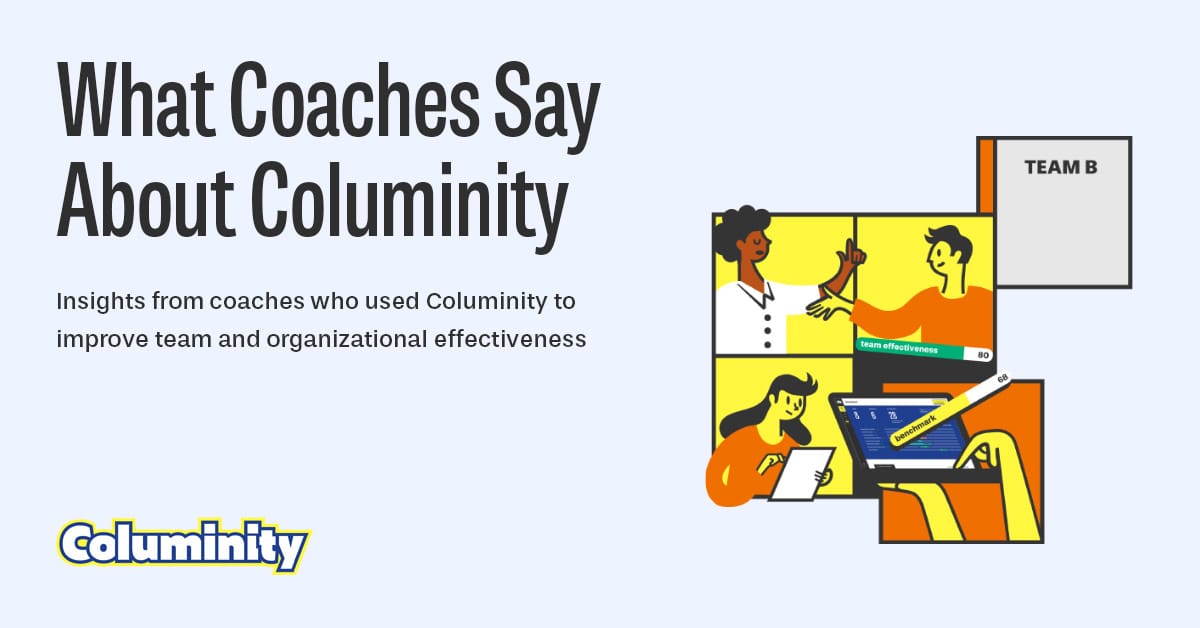What Coaches Say About Columinity

Columinity improves team and organizational effectiveness through data-informed decisions and scientific insights. You can diagnose one or many teams, receive evidence-based feedback, and resolve broader organizational issues. It helps to make decisions based on quantitative and qualitative data and insights from research, instead of only on gut feeling, opinions, or intuition.
Over the past few months, we have had in-depth conversations with coaches from a wide variety of organizations, exploring how they use Columinity to support team and organizational effectiveness. What we heard was consistent: Columinity isn’t just about collecting data—it’s about unlocking new possibilities for continuous improvement, empowering teams, and strengthening leadership engagement.
In this post, we’ve compiled 10 key takeaways from those conversations—insights that demonstrate how Columinity is influencing the way coaches work and what it could mean for your organization.
1. “Start meaningful team conversations.”
Coaches consistently shared that Columinity changes the nature of team discussions. Instead of simply reviewing scores or metrics, teams are encouraged to reflect and discuss what lies behind the data. These conversations build trust, increase openness, and help teams take ownership of both their challenges and their growth. It encourages participants to speak up, even about complex topics. Over time, teams become more confident in having the conversations that matter most.
2. “Use instant insights for action.”
Real-time feedback means teams don’t have to wait for quarterly surveys or leadership reports. They can talk about what’s going on now, when it still matters. This immediacy helps prevent issues from escalating and creates momentum for quick, informed action. Coaches notice how much more motivated teams are when they see direct results from their conversations. It also helps maintain energy between retrospectives or other reflection points.
3. “Give teams ownership of improvement.”
Coaches highlight how Columinity supports teams without judging them. With self-assessments at the center, teams feel in charge of their progress rather than being externally evaluated. That sense of autonomy drives more authentic engagement and a stronger commitment to improvement. It’s about helping teams guide their own development, not managing them into a fixed model. This shift boosts confidence and accountability within the team.
4. “Encourage deeper team discussions.”
Teams often uncover differences in perception they wouldn’t have otherwise noticed. These conversations allow them to explore what’s working, what’s not, and where misalignment might be holding them back. The result is more clarity, more alignment, and more shared responsibility. Coaches say these deeper insights often lead to stronger collaboration. The process also strengthens relationships, especially when tough topics are handled with care.
5. “Create a learning rhythm.”
Columinity makes regular reflection easy to maintain. Instead of relying on occasional retrospectives or one-off check-ins, teams build a habit of learning together. This steady rhythm keeps improvement alive and prevents teams from slipping into autopilot. Coaches see it as a simple way to embed agility into everyday work. The ongoing cadence helps teams stay focused, even during busy or turbulent times.

6. “Use insights for supporting leadership.”
Coaches utilize aggregated patterns across teams to support leaders in making more informed decisions. They can highlight where support is most needed or where strengths can be amplified. This creates a bridge between team-level insights and organization-wide improvements. Leaders get a more grounded view of what’s really going on, rather than relying on assumptions. And because the data is team-driven, it’s easier to act on with confidence.
7. “Reduce resistance with clear value.”
When teams see how Columinity helps them directly, skepticism fades quickly. It’s not just another survey—it’s a tool that fuels real conversations and helps them move forward. Coaches say this clarity makes it far easier to introduce without pushback. Teams appreciate that it’s designed for their benefit, not just to report upwards. That sense of purpose helps drive stronger engagement from the start.
8. “Focus on team growth, not comparison.”
Instead of pitting teams against each other, Columinity encourages internal growth. Teams feel supported to improve in ways that suit their own context and challenges. This leads to a more constructive culture where learning matters more than ranking. Coaches find it helps shift the conversation from blame to curiosity. It also removes the pressure of needing to “look good” in the data and instead invites honesty.
9. “Keep it lightweight and simple.”
Coaches appreciate how easy it is to get started—no long onboarding, no complex tools. The short, focused surveys fit into the team’s rhythm without disrupting their work. This simplicity helps ensure consistency and keeps the focus on meaningful dialogue. Teams are more likely to stick with something that doesn’t feel like a burden. It lowers the barrier to entry while still delivering strong insights.
10. “Scale impact across the organization.”
Even when it starts with just a few teams, the effect often spreads. As more teams see the value, interest grows organically across departments. Coaches describe how Columinity becomes a foundation for a shared culture of continuous improvement. Leaders begin to speak the same language as teams, which strengthens alignment. Over time, it supports not just team effectiveness—but organizational coherence.
Closing words
These insights demonstrate how coaches are utilizing data not only to measure team effectiveness, but also to spark meaningful conversations and support ongoing learning. Whether it’s creating space for reflection, spotting patterns, or helping teams take ownership of their growth, the impact goes beyond numbers. What stands out is the shift toward simpler, more human-centered ways of working. Across different contexts, the goal remains the same: helping teams and organizations thrive!
Go to columinity.com to try it now. Our free plan is ideal for individual teams, but with a paid plan, you can track multiple factors across multiple teams within your organization.


